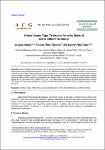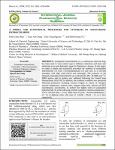Search
Search Results
Danshen (Salvia miltiorrhiza) is a one of the most well-known medicinal herbs in the Oriental medicine for treatment of certain cardiovascular disoders. Our current research on triterpenoid component in danshen roots led to the isolation of a new highly hydroxylated ursane-type triterpene, urs-12,20(30)-dien-3β,7β,24-triol-28-oic acid (2) and one known triterpene, epiasiatic acid (1). Their structures were elucidated on the basis of extensive spectroscopic analyses including NMR and MS spectra and comparison with literature data. The new compound 2 showed medium activity against HL-60 cells with the IC50 value of 16.3 μM. The obtained results of unique bioactive triterpenes from danshen contributed not only to its phytochemical profile associated with chemotaxanomy but also to biolo... |
Amantadine hydrochloride (1), a well-known antiviral drug, has been used to treat certain type-A influenza infections and been also medicated as an anti-dyskinetic agent for Parkinson’s disease. In this paper, we report a simple and economical procedure for synthesis of amantadine hydrochloride (1) from 1-bromoadamantane (3) and urea in a one-step procedure with high yield (81%) and advantage. The structure of the obtained amantadine hydrochloride was confirmed by MS, 1H-NMR and 13CNMR spectra and its quality was validated following the United State Pharmacopeia (USP 38). In addition, the synthesis condition was optimized following parameters including reaction reagent as source of nitrogen, reaction temperature, reaction time, reagent molar-ratio, solvent and HCl concentration, suc... |
Network coding (NC) has been recently emerging as an excellent technique for leveraging network efciency. In optical networks, NC and protection appear to be a good match and indeed, NC could be efectively exploited for greater protection efciency thanks to the opportunity of combining signals rather than duplication in the traditional approach. Motivated by this observation, we investigate the application of a simple and practical NC technique based on XOR operation to improve the network throughput in survivable optical networks. To this end, we propose the NC-based protection whose speed recovery is on a par with the conventional 1 + 1 dedicated protection while the capacity usage could be more efcient, paving the way for improving throughput in constrained capacity conditions. A... |



